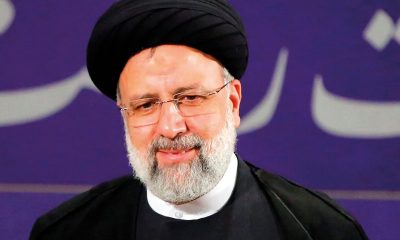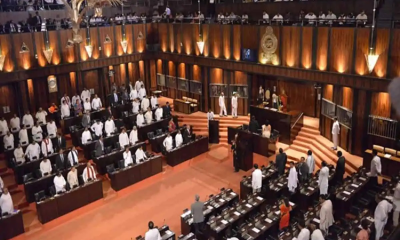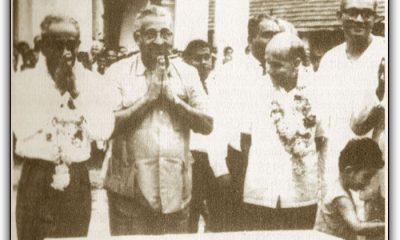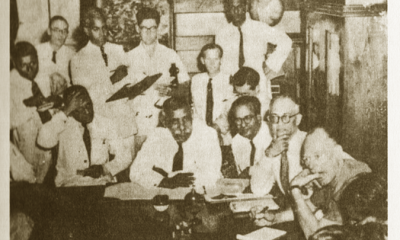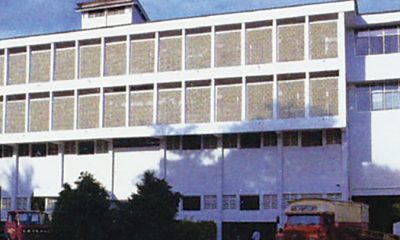Features
DS pilots ship of state, unlucky 13 at Senate refreshment room on Mar. 20, 1952

(Excerpted from the Memoirs of a Cabinet Secretary by BP Peiris)
It is time to get back to D.S. It was early 1950. The Prime Minister was firm that the de facto communist Government in China should be recognized. Some of his colleagues disagreed, but in the end gave way to the Prime Minister’s wish.
There then arose the controversy over the moving of a section of the Supreme Court out of Hultsdorp because of the congestion there. The Minister of Justice informed the Cabinet that he had consulted the Chief Justice, Sir John Howard, the General Council of Advocates and the Law Society. Only the Chief Justice had been helpful. The Minister had personally inspected many sites and had decided on a site at Bambalapitiya. A majority of the Judges of the Supreme Court were in favour of this site.
He had accordingly ordered that steps be taken for the acquisition of the land. Acquisition proceedings had, however, to be stopped when the General Council of Advocates and the Law Society made certain representations. The Council of Advocates had asked for an interview with the Prime Minister and, at this interview, had put forward a rebuilding scheme which the Public Works Department had described as an architectural monstrosity.
Apart from this, the scheme could not be carried out as the building operations would disturb the work of the courts. No alternative accommodation for the court building was available. As a compromise and a gesture of goodwill, he was prepared to retain in Hultsdorp the Assize Courts as well as the Election Courts in addition to the District Courts, and remove to the new site only the Supreme Court in its Appellate jurisdiction. In the end, the proposal was abandoned and the site used for the erection of flats to ease the housing problem.
In February 1950, Jayah, Minister of Labour and Social Services, left the Cabinet to take up the appointment as High Commissioner for Ceylon in Pakistan. He was succeeded by M. D. Banda.
There was much agitation at this time that education should be free, and the Cabinet was compelled to consider the problem and decide on the policy to be adopted. They came to several important decisions after many days of deliberation.
It was agreed that no tuition fees should be levied in Government Primary, Post Primary and Training Schools, in Government Vocational Schools, Training Colleges and in the University, In Primary Schools, the medium of instruction was directed to be the mother tongue, but English should be taught throughout the primary course as a second language. In Post Primary Classes of Sinhalese and Tamil Schools, as regards the medium of instruction, there was to be no change; but where it was not possible to teach certain necessary subjects through their existing medium, English might be used for these subjects.
In standards VI, VII, and VIII of English Schools, Sinhalese and Tamil, for pupils whose parents are Sinhalese speaking and Tamil speaking, should be introduced subject by subject, if necessary, as the media of instruction, in three successive years, as soon as the Government was satisfied that there was a sufficiency of teachers and books for carrying on the work adequately. Children were to be compelled to attend school from the age of five to 14, subject to exemption by the Minister in suitable cases after the age 12, and the exemptions were to be as few as possible.
Schools were divided into two grades – primary and secondary. Children assigned to post primary practical classes and those assigned to vocational schools were permitted to continue their academic education on payment of fees, if their parents wished, but were not provided for in the Government Schools. Scholarships and bursaries were to be provided in the University and other Government institutions for higher education.
The next important matter that the Government had to consider was the Report of Dr Cumpston on the Medical and Public Health Organization. Vital decisions were reached which gave rise to much agitation and controversy many years afterwards and had to be reconsidered by later Cabinets. One of the most controversial decisions was that all private practice by departmental doctors should cease and that all services given to the public by government salaried and pensionable doctors should be free.
This decision could not be implemented immediately. The Minister was therefore requested to formulate a scheme which would lead ultimately to the complete abolition of private practice for government doctors. At the date of writing, a half-hearted and unsatisfactory scheme of channeling a doctor’s practice is in force.
In August 1950, the Cabinet approved the National Flag. A Committee had been appointed to consider and report on this matter over which there were divergent views. Some sections did not approve of the predominance given to the Lion Flag. Hindus and Muslims wanted themselves represented in the flag In the end, to please all sections, different colours were added, as stripes alongside the Lion Flag to represent the different communities in the country.
In spite of the efforts of the Cost of Living Committee the cost of living was rising further, and the Government was compelled to increase the dearness allowance, and to subsidize rice to the extent of five cents a measure from December 1, 1950.
D.S., as I said before, was an amazing man. He was a hard worker and had no fixed hours of work. He forgot that the Government offices closed on Saturdays at 1 p.m. He did not know that a particular day was a Public Holiday. On such a day, he would arrive at his office to find it closed and would inquire, after getting back to Temple Trees, why the office was not open.
One incident, in which I was involved, is typical of the man. It was a Saturday, and I went to the Senate Refreshment Room for an aperitif. There were three others there – Senator Colonel T. Y. Wright, Senator Sarath Wijesinghe, my classmate at the Royal College, and my friend E. V. R. Samarawickreme, Clerk to the Senate.
I was making my way to another table when Col. Wright said, “Come and join us, young man”. I had a few drinks with my eye on the time. Even when one o’clock came along, I did not feel too easy because I knew that D.S. was working in his office. At a quarter past two (Saturday afternoon) we were still in the Senate when the Prime Minister’s peon walked in and said that I was wanted.
The Prime Minister had a problem and wanted my advice. In the Constitution and the Parliamentary Elections Order in Council, reference had been made to ‘British subject’. The Prime Minister desired to have this altered to ‘Ceylon citizen’ as regards the Election Order in Council, and wanted to know whether, if the amendment was made in that Order, a corresponding amendment would have to be made in the Constitution Order.
His purpose was to restrict the Indian estate labour vote. His difficulty was that an amendment of the Constitution required a two-thirds majority in parliament, and he had not the requisite majority. I answered “Yes, Sir” without reference to either of the two Orders in Council. He called for somebody’s opinion, which his secretary Atukorale brought in, and proceeded to read it out to me. The opinion was to the effect that the Elections Order could be amended without a corresponding amendment having to be made in the Constitution Order.
I said bluntly that the opinion was wrong. He said that I had given an opinion without reference to any books, and that what he had just read was the opinion of a King’s Counsel who had wanted a week’s time to give it.
I told him that, with all respect to the learned King’s Counsel, I was still of the view that the opinion was incorrect. He asked me for my reasons, and I said, still without reference to the Order in Council, that it was because of three words in section so and so in the Constitution Order (I remember using the words “umbilical cord”) which connected the two Orders, the significance of which the learned King’s Counsel had probably missed.
I also advised that if he was proceeding with the amendments, the Constitution amendment should be introduced first because it required a two-thirds majority to become law. “What do I do when you lawyers disagree?” asked the Prime Minister, and I replied that the question ought to be referred to the Law Officers of the Crown. Later, that was done; and the Law Officers agreed with me.
At that time however, the Prime Minister did not accept my advice. He introduced the amendment to the Elections Order first and got it through. He then introduced the amendment to the Constitution Order and failed to get the required majority. The result – the Elections Order today refers to ‘Ceylon citizen’ and the Constitution Order to ‘British subject’.
On another day, I went to the Senate Refreshment Room with Alexis Roberts to find a long lunch table laid for about 60 persons, and on inquiry, was told that it was the Judicial Officer’s lunch, that the Prime Minister was Chief Guest, and that he was due at 12.50 p.m. We drew two chairs and ordered drinks. The time was about 12 noon. The Judges were in conference upstairs. The Prime Minister had mistaken the time and arrived in the Refreshment Room at twelve-thirty.
There was no other guest present and we saw him approaching our table; he joined us and I introduced my friend. The Prime Minister inquired whether he was any relation of the late Dr Emmanuel Roberts, a general medical practitioner whose name is still respected and revered throughout the Island. When he heard that Alexis was the doctor’s youngest son, he was very happy because he had known the doctor well.
They talked of old times. We finished our drink but could not leave, as it would have been discourteous to leave the Prime Minister alone. I therefore asked him whether he could give me permission to order another drink (during office hours) and he said “Certainly, certainly, don’t mind me.” We took leave of him when we saw the Judges coming down the stairs to the lunch room and he thanked us for having kept him company all that time.
D.S. could be firm at times, but he was always polite. I once heard him tell a Permanent Secretary “If you can’t do your job, get out.” His telephone rang one day when I was doing some work with him and someone wanted to speak to one of his clerks, but, by a mistake, had dialed the Prime Minister’s direct number. Patiently, he put his work aside, turned up the directory and gave the caller the correct number. Can you imagine the Office Assistant to the Petrol Controller, referred to earlier, behaving in this dignified manner?
The Government had now to take some positive steps to deal with the problem of the rising cost of living. Several measures were considered. As a first step, it was decided to take over the control and distribution of essential foodstuffs like rice, flour and sugar. This was, I believe, the beginning of what later turned out to be virtual monopoly vested in the Co-operative Wholesale Establishment over the import and distribution of the Island’s principal essential commodities.
Came 1952. On February 6, I was attending a funeral at Kanatte when I heard someone, whom I did not know, say that the King was dead. The news had been announced from Radio Ceylon. The Prime Minister was a patient in the Merchant’s Ward of the General Hospital. I left the funeral and hurried back home as I knew that there would have to be an emergency meeting of the Cabinet. I called on the Prime Minister at the hospital and was directed to summon the Ministers to meet in his hospital room at nine o’clock the next morning.
There is no fixed place of meeting for the Cabinet. It has, apart from the Cabinet Room, met in the Prime Minister’s bedroom at Temple Trees, at Kandawela, at the Senate, in the Prime Minister’s room at the House of Representatives, and the Lodge at Nuwara Eliya.
Next morning, all the Ministers were present at the General Hospital. In attendance, there were Basnayake, Attorney-General, Sir Kanthiah Vaithianathan, Permanent Secretary to the Ministry of Defence and External Affairs, Sir Ivor Jennings, Vice-Chancellor of the University, and the Clerks to the Senate and the House of Representatives.
On behalf of his colleagues and on his own behalf, the Prime Minister placed on record their sense of the sad loss suffered by the death of His Majesty George VI. He had already dispatched a message of sympathy from the Government of Ceylon. The Cabinet recognized the succession to the Throne and agreed that the following Proclamation should be issued:
Whereas by the decease of our late Sovereign Lord King George the Sixth, the Crown is by our laws solely and rightfully come to the High and Mighty Princess Elizabeth Alexandra Mary; We, the Governor-General, the Prime Minister and other Ministers of the Crown in Ceylon do now hereby, with one voice and consent of tongue and heart, publish and proclaim that the High and Mighty Princess Elizabeth Alexandra Mary is now by the death of our late Sovereign of happy memory, become our Sovereign Queen by the name and style of Elizabeth the Second, to whom her lieges do acknowledge all faith and constant obedience with hearty and humble affection.
On previous occasions, the Proclamation acknowledging a new Sovereign had been signed by the Governor and ‘Other gentlemen of Quality’. On this occasion, it was decided that it should be signed only by the members of the Cabinet. The Governor-General, Lord Soulbury exercised his right to head the proclamation with his signature.
The Proclamation was read from the steps of the House of Representatives on February 8. In recording the minutes of the meeting held at the hospital, I marked the attendance of the lawyer Ministers as being Queen’s Counsel, instead of King’s Counsel which they were the previous day, and asked Sir Ivor whether I was correct. He said, “Yes. See the Demise of the Crown Act.”
March 20, 1952, was Mr D.S. Senanayake’s last Cabinet meeting. On that day, after the meeting, he entertained the Ministers and the Secretaries to lunch in the Senate Refreshment Room. Some Ministers were absent and I pointed out that 13 were sitting to table. I was sent out to bring somebody, some extra person, to make the number 14, but everyone I met appeared to have had his lunch. And so, 13 of us sat down to lunch. Minister Nugawela did not like it at all and said so.
Next morning, while on horseback, the Prime Minister fell off his horse although he was a good horseman. He had apparently had a stroke. He passed away the next day. Her Majesty the Queen was one of the first persons to send a message of sympathy.
Ceylon had lost the Father of the Nation. His wise leadership gave us peace and prosperity. There were no communal differences and controversies in his time. He had Muslims and Hindus in his Cabinet. He was not out for cheap notoriety. There was nothing mean or common in his nature, and his qualities of sincerity, good faith, and love of his native land have generally been accepted by the country. I have attempted to draw a vignette. Some future historian or research worker must give us his biography.
J. L. F.’ writing in the Ceylon Observer of March 23, 1952, said:
“Mr Senanayake was not merely a Prime Minister of a country: he was a leader of men. It was this quality both inborn and matured by experience which gave our country stability when he piloted the ship of state. His was not the leadership buttressed by bayonets and concentration camps in a country’s hinterland. The people followed him, and even his political critics admired him because he was known to be just. And a country of different communities, different religions and different castes needs at the helm someone whom they can all trust as a just man.”
Sir Alan Rose, Acting Governor-General, said:
“During my seven years in this country I have had the opportunity and happiness of seeing Mr Senanayake at very close quarters and from a variety of aspects. Quite apart from his many personal kindnesses, his inflexible courage, his power of mind and his breadth of outlook have combined to create an impression of greatness which I shall always remember.”
Features
Modi’s April 5th Colombo Splash and Trump’s Tariff Turbulence – As Time goes by!
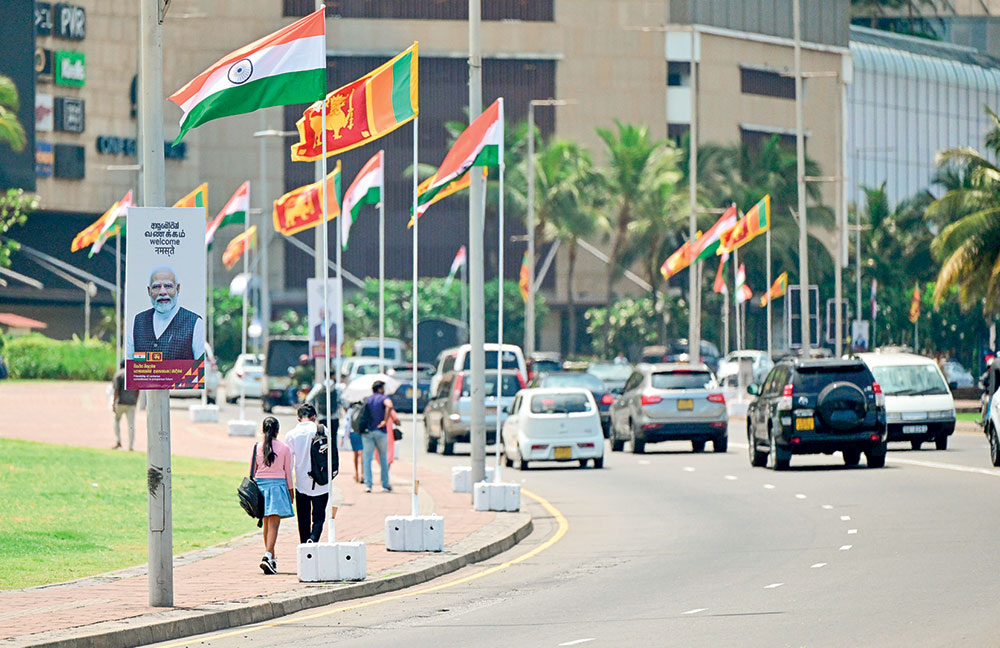
Prime Minister Modi is visiting Sri Lanka this weekend, from Friday, April 4th to Sunday, April 6th. This is Modi’s third official visit as Prime Minister, and the first since Anura Kumara Dissanayake became President and led the NPP to form a new government with a massive electoral victory. The official welcoming ceremony will be at the Independence Square on Saturday April 5th, 54 years to the day after the April 1971 insurrection launched by the JVP, the political progenitor of the present Sri Lankan government. Whether the historical irony of the occasion, if not the underlying coincidence, will be mentioned or memorialized at the official ceremony is unknown at the time of writing to meet the printer’s Friday evening deadline.
Anura Kumara Dissanayake was five years old in 1971 and, if my memory serves me well, Vasudeva Nanyakkara and Mahinda Rajapaksa might be the only living politicians from the 1971 parliament. They were both elected to parliament as young first time MPs in 1970. And quite by coincidence, there will be another wholly nostalgic gathering tomorrow in Colombo to remember Kumar David as comrade, professor and friend. In the 1970s, Vasudeva Nanayakkara, Wickramabahu Karunaratne and Kumar David were young LSSP Turks who were critical of both the JVP and the United Front Government of the SLFP, the LSSP and the Communist Party.
Vasudeva Nanayakkara has the singular distinction of being perhaps the only parliamentarian to be detained by the government both in 1971, in the wake of the first JVP insurrection, and after 1983 that ultimately precipitated the JVP’s second coming. In the now long historical perspective, the JVP campaigned for the United Front parties in the 1970 election and then took guns against them in 1971. The government’s ruthless put-down of the JVP in 1971 created a new template for state repression in Sri Lanka. And to round off the political circle, the 1971 repression helped the UNP to return to power in 1977, free the JVP leaders from jail, and then have its own violent tryst with the JVP in 1988/89. So, history repeated itself, but, pace Marx, both times as fake and both times as tragedy.
The LTTE added a third dimension to this otherwise two dimensional encounters, and by the time it was finished off in 2009, the JVP was emerging as parliamentary political force that at one time another formed governing alliances with the two SLFPs (first in its Horagolla version under Chandrika Kumaratunga and later in its Hambantota version under Mahinda Rajapaksa), as well as the UNP during its atrophying phase under Ranil Wickremesinghe. The Old Left itself, rather what was left of it, divided along the same three ways, and a cluster of them warmed up to JVP’s possibilities under Anura Kumara Dissanayake and his NPP umbrella. Kumar David himself became a prominent testifier for the new JVP/NPP possibilities using his weekly columns in the Sunday Island and the Colombo Telegraph to good effect. Indeed, in the last article he wrote before his passing, Kumar David congratulated Anura Kumara Dissanayake for his magnificent political achievement and expressed cautious optimism for the prospects under an NPP government.
Nostalgia aside, the serious political point here is that it would be a fool’s errand to trace the present JVP/NPP’s political lineage to the embryos of the 1971 or 1988/89 JVP. There is no unmutated political lineage in Sri Lanka. The political circumstances are also wholly different. The political reality over the last several decades has seen multiple scrambling of many eggs, including rotten eggs, to produce different governing omelettes at different times. The one that is obtaining now is a better product than most and one that is without the rotten eggs of the past. So, while there is historical irony in the NPP government’s April 5th official welcome to Prime Minister Modi, it would be incorrect and unproductive to read too much into it.
Trump’s Mad Old World
Far more than domestic realities, there is literally a world of difference in world politics between now and the 1970s. Donald Trump has seen to it this week with his globally sweeping reciprocal tariffs. He has put the planet’s trading system on edge, calling it America’s liberation day. He is not liberating anything, only reverting to the old ways of protectionism an in an insane manner. His forays are a belated assertion of outdated economic idiosyncrasies that he has been harbouring for all his pre-political life when no one took note of him politically speaking.
In the 1970s, Trump was a brash, young, New York upstart. And Modi in India was an RSS activist and made his first larger political mark in organizing protests against Indira Gandhi’s Emergency Rule. He was understudy to the flamboyant George Fernandes, later India’s foreign minister, and a socialist comrade of LSSP exiles in India who contributed their own mite to Mahatma Gandh’s mighty Quit India movement. Now Trump and Modi are at the pinnacles of national power in their respective countries. So is Anura Kumara Dissanayake, much younger and also far more composed and self-controlled.
Trump is unleashing disruption throughout the world, unilaterally upending the postwar world order that was set up under American leadership to oversee global trade and financial transactions. On balance, it has more than served its purpose of stabilizing world capitalism while releasing the human potential and resource endowments of many non-western countries, especially Asian countries, to emerge as robust economies and adding a long needed balance to the lopsided world economy hitherto dominated by the old industrial countries of the west. But these changes by themselves have not weakened the western economies and the European Union and most Americans other than Trump have to come to terms with them in a positive way.
Trump is abhorrent of these changes but not owing to any rational political reasons or objective economic considerations. Those who try to make sense of Trump’s erratic two months in office are beginning to see his obsessive egotistical compulsion to go down in history as America’s greatest president by simultaneously pursuing three unprecedented objectives: physically expand America’s boundaries – to wit his rantings over Panama, Greenland and Canada; make America great again by reverting to the 19th century mechanism of tariffs and dismantling the late 20th century framework of free trade; and by constantly musing about running for a third term in calculated disregard of the clear constitutional provision since 1947 limiting presidents only to two terms in office.
Underlying these pursuits are Trump’s crass racism, his lack of empathy for those who are structurally kept behind in the economy, and his envy towards those and against whom he measures himself and feels culturally inferior. The highs and lows of Trump’s universal tariff structure are reflective more of his biases than of any economic strategy. It is not by accident that Europe and Asia are set apart for special punishment, especially the ASEAN countries, and of course China. Putin’s Russia is not on the list.
At 44%, Sri Lanka is among the 15 worst hit countries in the world, and all of them are countries with small to medium size populations and at varying levels of economic development. At less than USD 3 billion, Sri Lanka’s share of US imports is less than 0.5%, but the US accounts for 23% of Sri Lanka’s exports – the single largest country share. The increased revenue to the US treasury from the increased tariffs on Sri Lankan goods would be less than a drop, while the consequences for Sri Lankan exports, especially the apparel sector, could be potentially disastrous. But there may not be a loss of market for apparel products in the US depending on their current price levels and consumer preferences.
The reciprocal tariff levels are generally 50% of what US has calculated to be the general tariff level against US imports by different countries. But this method of calculation has been criticized because it is based on trade deficit and is not a weighted average of tariffs on individual goods. There is madness even in the method of the Trump Administration. So, for Sri Lanka, the US reciprocal tariff of 44%, and it could be interpreted by a Trump official as generous 50% of the 88% tariff that Sri Lanka is unfairly applying to each imported good from the US. Never mind US imports to Sri Lanka amount to about USD 500 million. At the bottom end of the food chain, Sri Lanka apparently exploits America by a huge trade deficit! The same argument is writ across every country from Canada to China.
By these tokens, India has one of the lower reciprocal tariff levels at 27% in Asia and South Asia, while Bangladesh is slapped with 37% reciprocal tariff and Pakistan with 30%. More importantly, among the larger economies, India is taking a reportedly measured response to Trump’s tariffs as part of its preferred alignment with the Trump Administration. India appears to be keen on avoiding a confrontation with the US, while looking to expand its export mix to the US by taking advantage of the high tariffs imposed on other countries. For example, India is apparently looking to expand its export of electronic goods to US by taking advantage of the high 46% reciprocal tariffs applied to Vietnam which has a well established export sector in electronic goods.
To get back to where I started, Trump’s tariff turbulence bears a more crucial backdrop to Prime Minister Modi’s visit this weekend than the April 5th anniversary that falls on Saturday. Even the set agenda for talks between the Indian Prime Minister and Sri Lanka’s President could be overshadowed by Trump’s announcement of reciprocal tariffs. Not a single country is bent on retaliating to Trump’s tariffs for the sake of retaliation. Every country other than the US is keen to get rid of the tariffs, Trump willing.
The US accounts for 13% of global trade, and if the countries that account for 87% of world trade can deal only with the US without descending into tariff slaps between them, the US will be isolated, and Trump will have to face the wrath of the American consumers hit by rising import prices sooner than now expected. That would be the ultimate way out for the rest of the world from current American madness.
by Rajan Philips
Features
Cardinal vs Mastermind

The Easter Sunday bomb attack on three churches and four hotels on April 21, 2019 that left 269 dead (including 40 foreigners) and wounded about 500 was a day of infamy. It had shattered the peace and tranquility if not also harmony that prevailed from 2009. This was after 30 years of fratricidal conflict (100,000 dead) and 18 months of terrorism (60,000 dead at over 100 a day in a year and a half between 1988-9) had ended.
The agony, grief and pain became boundless when it was discovered that specific actionable operational intelligence received on the April 4, 2019 and thereafter continuously until D Day (Apr. 19) from an undisclosed Indian intelligence agency had been handled with total incompetence and mindless indifference. Despite the said churches and hotels being accurately identified as targets, the crack STF was sent to guard the Indian High Commission where they did a great job!
Into this cataclysmic inferno that had paralyzed all government leaders, stepped Cardinal Malcolm Ranjith. By his words and actions, he prevented any retaliatory attacks in a country with a despicable history of mob violence. He was SL’s hero, honoured, respected and loved by all.
Foreign Intelligence and Investigation agencies including the Federal Bureau of Investigation (FBI), Australian Federal Police (AFP), Internal Security Department of Singapore (ISD), Israeli (Mossad) and of course Indian, investigated the tragedy. They reported back to their governments that all the perpetrators, ideological extremists linked to ISIS, a proscribed global terrorist organization, were dead. Blood relative collaborators of the two families involved, anticipating arrest, had committed suicide in their homes as far apart as Kattankudy and Colombo. Nearly 800 other suspects were arrested of whom more than 700 were either bailed out or released, bringing no credit to the already discredited Police.
Only 25 of them have been charged in court. There was no second wave although scaremongers and instant experts warned that there was a possibility of more attacks. Just to make sure, SL through its heads of missions in USA and Australia, contacted the FBI and AFP respectively. It reassured SL the case was closed.
This wasn’t good enough for some in SL where politically biased rumours are the essence of life. Uttering untruths is mother’s milk to the majority. About two years later certain biased media started creating doubts as to who had ‘organized’ the suicide bombings. Despite the conclusions reached by the world’s best known Intelligence and Investigation agencies (less the KGB that had no immediate interest) even the good Cardinal had been persuaded by discredited state intelligence officers that there was a suspected ‘mastermind’ with a murderous political motive behind the attack.
They had drawn attention to the fact that the dysfunctional government in power was vapourised at the general elections the following year. That this defeat was an obvious consequence to their miserable performance was ignored. No attempt to ask for India’s help was made. Why?
So SL was asked to believe that in its society there existed possibly two barbarians in the mould of Ghengis Khan who could plan and execute mass murder just to take over state power. They played on the inherited and exploited gullibility of the people. It was Goebbels who brilliantly proved that a lie continuously repeated was eventually believed. And there was no TV then. How perfidy thrives.
By coincidence a couple of CID officers too were apparently spreading this very same story about two military officers. That the local government elections a year before the Easter Sunday tragedy, had seen the despised government trounced, appeared to have been conveniently or deliberately forgotten, a national trait. It immediately drew attention away from the guilt of a criminally negligent government and police intelligence. Politicians who had been like mice then, now appeared and joined the chorus.
The Cardinal thereafter never let go. He didn’t think that the FBI, AFP, and other world class Investigation agencies should have the last word. He placed his faith in the informants from the police. Their Intelligence heads and the IGP were found guilty and punished (together with the President) for criminal negligence in the Easter Sunday massacre. He embraced them. The victims were almost all from his Catholic flock. He was fighting for them. He would be relentless and unforgiving to the point of becoming obsessed.
There was a time when defenestration was practiced by the Police. The deaths in 1966 of Sergeant Tilakewardene and Dodampe Mudalai after being thrown from the fourth floor of Police HQ was an example of how ‘evidence’ was obtained. Maybe the Cardinal did not know. Many Catholics however believed he was becoming political. He may have become insensitive to the fact that giving false evidence was an age old tradition. In that SL was world class
There were seven bombers. Four of them were poor radicalized youth led by Zaharan Hashim who even fought the more conservative adherents in Kattankudy with swords. The Colombo three were from a very rich and highly educated family.
The evidence the Cardinal trusted most were the ramblings of one Azad Moulana now seeking asylum in Europe, the involvement of Director Military Intelligence (DMI) and the telephone calls made by the hesitant bomber who left the Taj Samudra hotel and blew himself up in a ‘hotel’ near the Dehiwala Zoo.
According to Moulana, self styled ‘Coordinating Secretary’ to Pillayan and now a self-confessed accomplice to acts of terror thereafter, the Directorate of Military Intelligence (DMI) and Pillayan who was in Batticaloa prison, conspired to brain wash and train Zaharan and three others to murder Christians. The four were being held in the same prison as Pillayan.
The fact that the Director of Military Intelligence (DMI), Maj Gen Suresh Sallay, had been serving at the SL High Commission in Malaysia from 2017 for two years and immediately thereafter one year (2019) in Delhi at the National Defence College (NDC) at the exact time he was supposed to be in SL, appeared to be of no consequence to Moulana and his new ‘accomplices’. They said Gen Sallay had visited SL between tours.
This was supposed to be enough time to visit Batticaloa prison, conspire with four terrorist suspects (who had vandalized a Buddha statue in Mawanella) to kill two policemen on guard duties at Vavanativu, train them in shooting, and store explosives and detonators in Puttalam. Was Gen Sallay training at the College of SL Miracles and not the NDC?
Who is Maj Gen Suresh Sallay? Did the Cardinal know he had been an outstanding officer after initially joining the Infantry (Gemunu Watch). He ended up serving in the Military Intelligence Corps where his intellect, analytical skills, trilingual fluency and excellent writing skills, if not his rugby were assets. He became DMI and was later the first military officer to head the State Intelligence Service (SIS) in a 40-year career. His mother is a Catholic, father a Malay and his wife a Buddhist. Is it the profile of a ‘mastermind’ of a radicalized extremist terror group that the Cardinal and his informants prefer to believe.
Finally, let’s get back to the Taj Samudra hotel bomber who hesitated. He was seen coming out of the hotel without detonating his bomb. He was seen on CCTV talking to someone. That was apparently conclusive evidence that he had a handler who was reporting to a mastermind. He went from there to an obscure ‘hotel’ near the Dehiwala Zoo. Later he was seen going to a mosque for prayers after which he went back to the same ‘hotel’ where he blew himself up, killing two people, not obviously an agreed target.
But what if there is a recording of his conversation? Was it with a woman? Could the woman be his wife? Who else would a suicide bomber listen to and then hesitate to perform? Who else would attempt to dissuade him other than a person who knew she would be a widow soon, if she did not succeed? Can the Cardinal and his informants mull this over?
Is this why the Cardinal has now said he was going to take to the streets? He has said he is unhappy that the government leader who said he would bring the mastermind to face justice has disappointed. The Cardinal would lead protests on the streets. Actually it is the Katunayake highway. His followers would march up and down from Katuneriya to Colombo and back.
Are his informants converts not to the church but to political opportunism? Did they rush to the Cardinal to ask for still more time? Maybe until doomsday? Maybe the very Good Cardinal and his closest lieutenants will now have more time to attend to the church and all his flock instead of bucking the world’s best Intelligence and Investigation agencies and cavorting with imaginary masterminds.
What must not happen is that this endless mistaken media extravaganza does not end in communal disharmony or worse. It has thus far been avoided as the pain that the Catholics endure has been shared by all.
There should also be an apology to Gen Suresh Sallay too. He has conducted himself with dignity and restraint as an officer and gentleman under extreme stress in deference to the Cardinal.
by Zingara
Features
Karu Jayasuriya’s time as Mayor of Colombo:revenue gains and effective administration
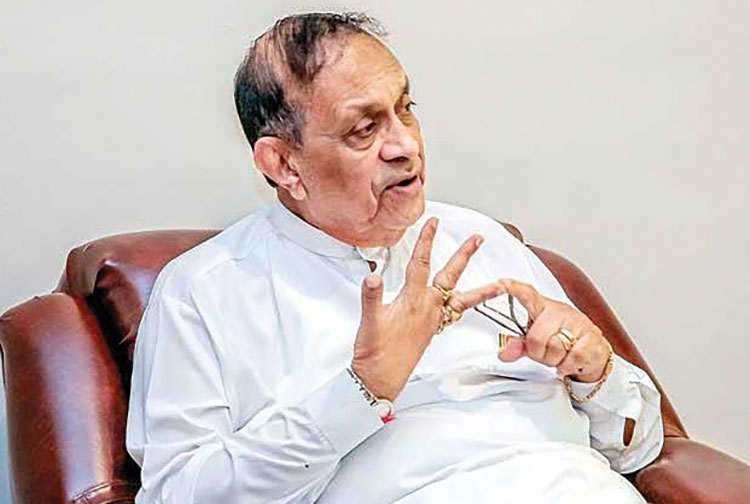
Back stabbing within his own party, CBK keeps to time
During his time as Mayor of Colombo, Karu Jyasuriya had refused to avail himself of benefits and entitlements, opting to spend his own funds for necessary expenditure. These included the monthly allowance, refreshment allowance and fuel allowance allocated to the Mayor. Instead, he ensured that all allocated allowances were routed to the Mayor’s Fund and were utilized for the betterment of the City and its residents.
Karu even declined to accept the official vehicle provided by the Colombo Municipal Council (CMC) and instead used his own vehicle for official Mayoral work. But this did not dissuade opposition members of the CMC from questioning Karu at every council meeting demanding to know details of CMC funds spent by his administration. “What is your monthly fuel allowance?” or “How much did you spend on fuel last month?” were common questions thrown at him.
These questions and jibes by the opposition often made it to the headlines of the government-run ‘Lake House’ newspapers the very next day. The headlines featured were along the lines of “Council member questions Colombo’s Mayor on his fuel allowance…!!” or “CMC members express suspicion that Mayor has secretly increased refreshment allowance in the past months…!!”
According to Karu, despite replying to these unfounded allegations, the rejoinders were not featured prominently in print. “More often than not they were completely ignored by the newspapers…” he says. To his dismay, Karu was to later find out that certain politicians of his own party were behind the acts of these opposition council members. Feeling insecure and threatened by Karu’s rising popularity among the people, these United National Party (UNP) politicians had allegedly bribed several opposition councilors to pose embarrassing questions to the UNP Mayor.
“I heard that sums up to five thousand rupees were paid to ask certain questions. The same tactic was being used to publish them in government-owned Lake House” Karu alleges. He believes this was yet another unfortunate result of the competitive preferential voting system in the country that often pits party colleagues against each other.
But an unruffled Karu had merely continued with his work. In addition to the special committee consisting of councilors, Karu also took steps to form an advisory committee of professionals from various sectors to provide necessary advice and guidance to the administration of the CMC.
According to Karu, these professionals were unpaid and provided their services voluntarily. “Several experts and professionals were also called in to analyze and provide feedback on the CMC and its functions in the hope of receiving constructive criticism…” Karu says.
Housing for the underprivileged in Colombo was also an issue during Karu’s time as mayor. Several families living in Colombo city limits at the time had sought shelter in dilapidated shipping containers due to the lack of adequate housing. As Mayor, Karu had taken steps to construct new houses in Slave Island for these families, allowing them to leave their unsafe shelters behind and move into better housing provided by the city.
At that time Crow Island in Mattakkuliya was notorious as a paradise for criminals such as thieves, bandits and rapists. Shockingly, in just a short period several women had been raped and killed in the area. The gruesome incidents created a sense of fear among people. As Karu recalls, many had expressed their reluctance to travel through the area even during the daytime. Hearing these reports as Mayor, a concerned Karu visited Crow Island. What he saw was that the area was indeed enveloped in a dark and sinister feeling. Determined to change this image Karu directed the CMC to give Crow Island a much-needed face-lift. The result was a much more pleasant and welcoming Crow Island devoid of criminal activities.
According to Karu, by this time many of the roundabouts in Colombo were in a state of neglect. Coming up with an ingenious plan he decided to allow private companies in the area to maintain these roundabouts. “They were expected to beautify and maintain the roundabout allocated to them. The CMC did not pay them but instead, they were allowed to put up promotional signs saying they were maintaining the roundabout. This method was later adopted by many other municipalities of towns across Sri Lanka.
It was also Karu who first introduced high pressure water guns to rid the city of the poster menace. At the time Colombo’s walls and public spaces were covered with promotional posters of politicians, and tuition teachers as well as films and teledramas creating an unsightly scene. Several gangs of thugs had begun putting up these posters for a fee, and fights among them also became a common occurrence.
Karu says as a solution he decided to put up CMC sponsored notice boards on major roads and streets in Colombo for posters and other promotional material to be displayed. Next, he took steps to ban posters on walls and in any other public spaces. But as some groups continued to ignore the CMC’s directives, Karu refusing to back down introduced high pressure water guns dubbed ‘Poster Killers’ by the public to remove any material displayed on any surfaces not allowed by the CMC. Every day after midnight CMC workers would set out to remove posters in the city as directed by the mayor. According to Karu, the poster wars were significantly reduced thereafter.
During his time, Karu says the CMC funded the development and restoration of various places of worship located within the city of Colombo. Funds were provided to all religions with Karu ensuring no particular religion was favoured. One place of worship that benefited through this program was the Thai Temple located in Mattakkuliya, Colombo which was in a state of disrepair at the time.
As Mayor, Karu had also taken steps to renovate the popular Viharamahadevi open-air theatre to provide more space and facilities to hold various types of shows. The Old Town Hall building in Pettah and the Town Hall theatre were other venues that were renovated and modernized during his tenure.
Seeking to further improve facilities available to the public, Karu also observed that many public children’s parks dotting the city of Colombo were in a dilapidated state. He ordered them to be renovated and more facilities added so that children could play safely. The city’s public swimming pool also got a much needed face lift during this time.
According to Karu, the assessment of private properties to levy municipal rates on them, which was a key income stream of the CMC, was in total disarray at the time. “It was discovered that assessment taxes had not been collected for over a decade from many luxury houses in the affluent Cinnamon Gardens area in Colombo while others had only been taxed meagre amounts…” Karu recalls. He says this was a failure on the part of his predecessors who had failed to launch a proper investigation or assessment of the situation.
“The CMC was found to have lost millions of rupees in revenue as a result. I ensured the situation was rectified through the advisory committees and the income of the CMC shot up thereafter…” he says.
Meanwhile, in a bid to further end all corrupt practices and to address any shortcomings of the CMC, Karu decided to introduce a 24-hour investigation unit. The public could inform the newly formed unit of any issues at any time of the day by calling on the hotline introduced.
But Karu was also keen on giving Colombo’s residents the opportunity to approach him directly. To this end, he introduced the phone number 077 771 2345 on which the public could call him directly with any queries or issues faced by them. Karu says he would even receive calls in the middle of the night but took steps to provide immediate solutions to the many problems related to him by Colombo’s citizenry.
One day as Karu was having lunch, he received a call from Prime Minister Sirimavo Bandaranaike. “Karu the street lights in front of my house on Rosmead Place have not been switched off for three days. I saw your phone number in the newspaper and decided to call as I could not stand this waste any longer… she had said. Following the short conversation, Karu called the Municipal Engineer and instructed him to immediately rectify the issue.
While heads of organizations often prefer to hold on to all administrative powers, Karu during his 16-month tenure as Mayor of Colombo attempted to maintain a distribution of his powers instead. “I granted all necessary powers to my deputy Omar Kamil. Meanwhile, the required powers to take necessary action were also granted to the advisory committees headed by Municipal councilors, he recalls.
According to Karu, he was inspired to do so through his own personal experience. “I understood that people tend to work better when they are given the freedom and necessary powers to do so…” he says.
Karu notes therefore he ensured all Municipal Councilors in spite of their political party affiliations received the required administrative powers. “For example, though the UNP held the power of the CMC, I even appointed councilors from the opposition to head numerous standing committees in an attempt to distribute these powers…” Karu says.
It was during his time as Mayor of Colombo that it was announced Prince Charles, the heir to the British throne would visit Sri Lanka to attend the country’s 50th Independence celebrations. Karu engaged in conversation with Prince Charles during this visit and as Mayor of Colombo, was tasked with presenting the ‘Golden Key to the City’ to this Royal visitor.
To discuss the necessary arrangements, the then President, Chandrika Kumaratunga summoned Karu to ‘Temple Trees’ one morning. But with an already scheduled meeting at 10:30 a.m. with the West German ambassador, Karu found himself in an unexpected dilemma. This was because President Kumaratunga was notorious for her lack of punctuality. She would often arrive fashionably late even to official government engagements. Years later Kumaratunga would say this was because she would only move on to a task after finishing the one at hand, often making her late for the next appointment.
“Madam President, I will attend the discussion at 9 a.m. But if you get late I will have to leave as I must keep an already scheduled appointment for 10.30 a.m. with the West German ambassador…” Karu had responded. On the day Karu arrived at Temple Trees several minutes ahead of the 9 a.m. meeting only to be informed that the President was yet to arrive. “I will wait for thirty minutes…” Karu had thought to himself. But to everyone’s surprise, Kumaratunga had hurried in just two minutes past 9 a.m. saying “Karu I am sorry for the delay..!”
“The president was known to get late for hours on end. Some high-level diplomatic visitors were even forced to leave without having met her due to her tardiness. On the day though she was only delayed by two minutes and I was quite surprised that she apologized politely for having kept me waiting for that short time…” Karu says.
While the discussion that followed was cordial, President Kumaratunga had even humbly apologized for the false allegations she had leveled against him during the previous local council election.
During his 16-month tenure as the Mayor of Colombo, Karu believes he was able to serve the people of Colombo and also increase the revenue of the CMC due to his policy of delegating the administrative responsibilities of the Council to work as a team. Karu had only given leadership when necessary and worked towards improving the management of the CMC.
A prime example of this is the ’99 Day Rapid Development Program’ initiated by him. Karu says the program proved more successful than he had initially expected due to the time and effort put in by all staff of the CMC. “We worked on all holidays and weekends during this program…” Karu recalls. Even though senior staffers of the CMC are not entitled to overtime pay and therefore could not be forced to work on holidays, Karu says certain female engineers had chosen to report to work even on holidays during this program despite being pregnant at the time.
Moved by their commitment and dedication Karu was able to later provide these employees with a oneoff allowance for the work carried out during holidays after obtaining permission from the Chief Minister of the Province and the Attorney General after getting a motion passed at a CMC meeting.
Karu recalls the program and the relevant development activities carried out had so impressed the West German Friedrich Naumann Foundation that it led to the program getting international attention.
Perhaps due to his background, Karu had always attempted to carry out many development programs with the assistance of the private sector. This was made easy due to the image he had built over the years as a successful entrepreneur in the private sector. Towards the end of his tenure, Karu had sought to commence a recycling project in the town of Meepe which was to be funded by the Asian Development Bank (ADB). The results of the feasibility study confirmed the project would pose no harm or threat to the environment.
However, politicians of the People’s Alliance representing the areas of Avissawella, Homagama and Maharagama not only voiced their strong opposition to the proposed project but also propagated a negative view about it among residents of the area. As a part of this campaign, all politicians of the Colombo district representing all political parties hoping to contest the then upcoming provincial council elections were called to make a public pledge promising to not allow its implementation if elected. Among those who chose to take this pledge were all the provincial council hopefuls of the UNP. According to Karu, possible environmental impacts of the project had been exaggerated to obtain this result. Karu’s opposition was to no avail. Faced with stiff public opinion from residents of Meepe, the ADB decided to withdraw from the project and commit the funds elsewhere in the region.
At the time a well-known care home for senior citizens in Borella was managed by the CMC. While this institution was home to many elderly women and men, it was no secret that the place was riddled with corruption. Having ordered an investigation into these allegations, Karu discovered that many of them were true. “Some were even profiting off the meals and food items intended for the elderly living in the care home. Even though it was required that healthy and nutritious meals be provided to the residents more often than not the meals were paltry and far from nutritious…” Karu recalls.
He not only put a stop to the corrupt practices, but was also able to obtain the support of various private businesses, the Lions Club and the Rotary Club to organize volunteer programs at the care home. Karu was also able to move the care home to a better fully equipped facility in the town of Battaramulla during his tenure as mayor.
But even as Karu implemented various new plans while working towards the betterment of Colombo’s citizenry, this resulted in a number of UNP stalwarts feeling insecure and threatened by him. Many thought Karu would overshadow them and become more popular among the people. This prompted them to launch a secret campaign against their own colleague. According to Karu, it was this campaign against him that eventually forced him to shift his political career from Colombo to the Gampaha district.
(Excerpted from the biography of Karu Jayasuriya by Nihal Jagathchandra)
-

 Business2 days ago
Business2 days agoStrengthening SDG integration into provincial planning and development process
-

 News6 days ago
News6 days agoBid to include genocide allegation against Sri Lanka in Canada’s school curriculum thwarted
-

 Business1 day ago
Business1 day agoNew SL Sovereign Bonds win foreign investor confidence
-

 Sports3 days ago
Sports3 days agoTo play or not to play is Richmond’s decision
-

 Business1 day ago
Business1 day agoDaraz Sri Lanka ushers in the New Year with 4.4 Avurudu Wasi Pro Max – Sri Lanka’s biggest online Avurudu sale
-

 Latest News5 days ago
Latest News5 days agoIPL 2025: Rookies Ashwani and Rickelton lead Mumbai Indians to first win
-
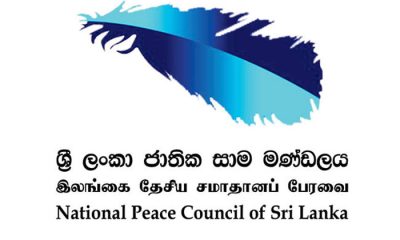
 News6 days ago
News6 days agoSL needs a comprehensive solution, not selective justice: NPC
-
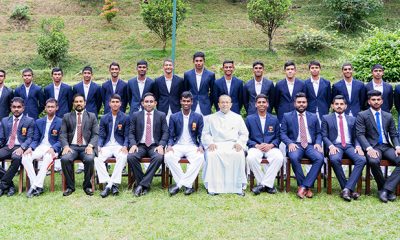
 Sports4 days ago
Sports4 days agoTrinity, St. Anthony’s out to end decade long victory drought


